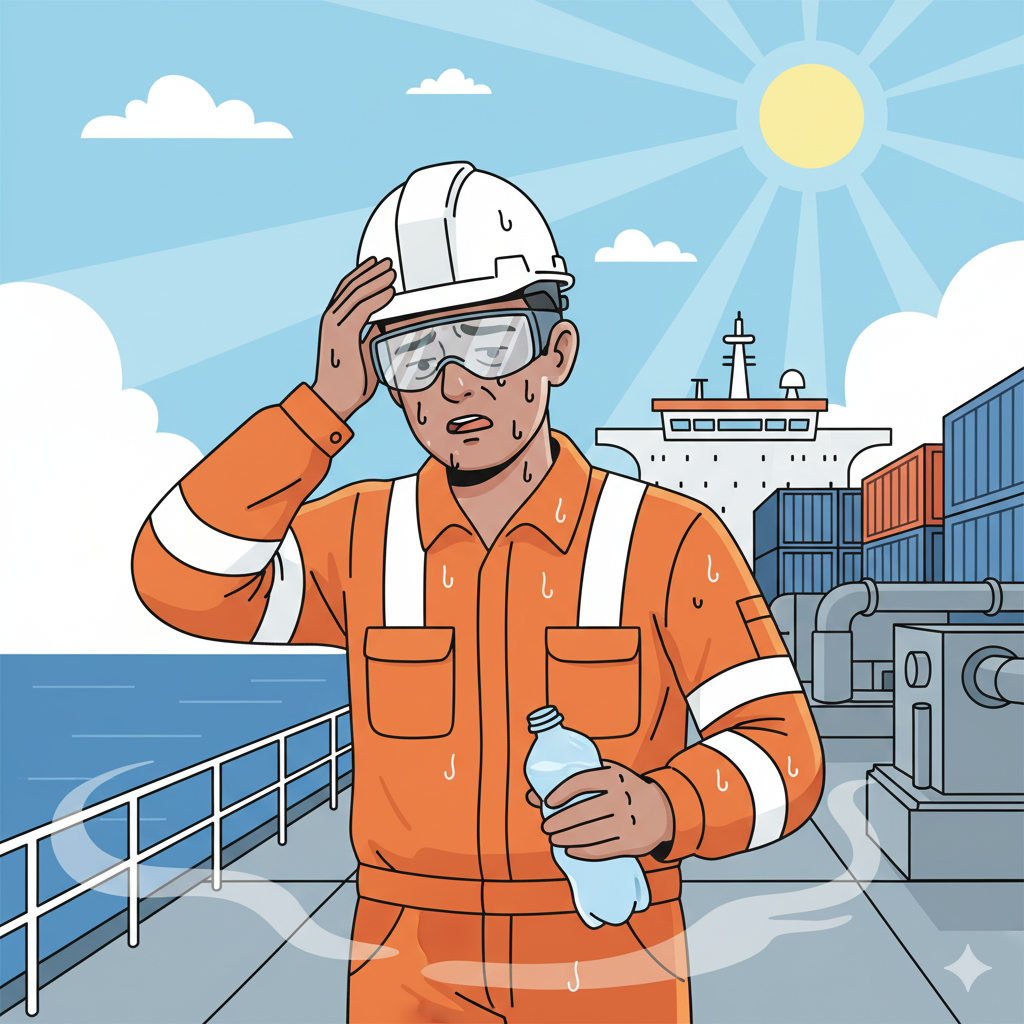Aug 29 • Maritime Trainer
Heat Stress at Sea: How Seafarers Can Stay Safe Under Extreme Conditions
Heat stress is an invisible but very real risk onboard ships. While most maritime professionals are trained to deal with physical hazards like machinery or navigation challenges, exposure to prolonged heat is often underestimated. For seafarers, who spend long hours working under direct sunlight and in engine rooms with limited ventilation, the consequences can be severe — leading to fatigue, confusion, or even life-threatening heatstroke.
In this blog, we explore what heat stress is, why it is dangerous, and most importantly, how crews can prevent it.
What Is Heat Stress?
Heat stress occurs when the body cannot regulate its internal temperature due to excessive exposure to heat. Normally, the human body cools itself through sweating and circulation. But when heat exposure overwhelms this natural balance — especially in humid maritime environments — the body temperature rises, placing strain on vital organs.
Common signs of heat stress include:
- Dizziness or lightheadedness
- Headaches and nausea
- Muscle cramps
- Fatigue and confusion
- In severe cases: loss of consciousness or heatstroke
These symptoms not only endanger individual crew members but can also compromise vessel safety, as impaired judgment at sea can lead to serious accidents.
Why Heat Stress Is a Growing Concern in Shipping
Maritime operations are increasingly affected by climate change and rising global temperatures. According to the International Maritime Organization (IMO), seafarers are among the frontline workers exposed to extreme weather conditions. Deck operations under the blazing sun, enclosed machinery spaces, and long duty hours contribute to heightened risks.
Moreover, safety standards such as TMSA and SIRE 2.0 highlight the importance of crew health and well-being, emphasizing proactive measures. Shipping companies that fail to address heat stress not only face operational risks but may also encounter compliance issues.

Heat Stress Prevention Checklist for Seafarers
Maritime Trainer has developed a practical Heat Stress Checklist to help crews reduce risk and stay safe onboard. This simple yet effective tool serves as a reminder during daily operations:
- Stay Hydrated – Drink water regularly throughout your shift. Avoid excess caffeine, which accelerates dehydration.
- Wear Light and Breathable Clothing – Use lightweight, reflective, and protective gear to minimize heat absorption.
- Take Regular Rest Breaks – Schedule short breaks in shaded or air-conditioned areas to allow the body to recover.
- Monitor for Symptoms – Watch for early signs such as headaches, dizziness, or unusual fatigue. Address them immediately.
- Support Your Crewmates – Look out for colleagues. A quick check-in can prevent a small issue from turning critical.
This checklist aligns with occupational health best practices and is designed to integrate seamlessly into daily safety routines.
Building a Culture of Awareness Onboard
Checklists are only effective if they are supported by the right culture. That means:
- Training: Crews must be educated not only on technical tasks but also on personal safety, including recognizing heat-related risks.
- Leadership Example: Officers and supervisors should actively encourage hydration breaks and symptom reporting.
- Technology Support: Digital platforms like Maritime Trainer’s MTCare Program can monitor crew well-being through pulse surveys, ensuring issues like fatigue or stress are detected early.
By making health and safety a shared responsibility, companies can improve both performance and crew retention.
How Companies Benefit from Heat Stress Prevention
Beyond protecting individuals, prevention strategies have a direct impact on company performance:
- Reduced Incidents: Healthy, alert crew members are less likely to make costly mistakes.
- Higher Productivity: Regular breaks and hydration improve efficiency rather than reduce it.
- Regulatory Compliance: Aligning with standards like RisQ and TMSA demonstrates commitment to safety and ESG values.
- Crew Retention: Caring for seafarers’ well-being strengthens loyalty and reduces turnover.
Heat stress prevention is not just a medical necessity — it’s a business advantage.
Looking Ahead: The Future of Crew Well-Being
With global temperatures expected to rise, heat stress will remain a long-term challenge for the maritime industry. Forward-thinking companies are already investing in:
- Blended Digital Learning modules that teach prevention strategies.
- VR and Cloud Simulation scenarios where crews practice safety in realistic environments.
- Data-driven BI Tools that track health trends across fleets.
Such innovations not only enhance safety but also reflect a company’s commitment to sustainable and responsible shipping practices.
Conclusion
Heat stress is a silent risk that can escalate quickly if overlooked. For seafarers, awareness and prevention are the best tools against this invisible enemy. By following simple steps — hydration, clothing, breaks, monitoring, and mutual support — crews can stay safe, and companies can ensure both compliance and efficiency.
At Maritime Trainer, we are dedicated to empowering seafarers with practical training and tools like the Heat Stress Checklist. Together, we can create safer, healthier, and more sustainable operations at sea.
Join Our Newsletter
Subscribe to get our monthly health and safety bulletin free.

Innovative digital learning technology and services provider
Partnership
Become A Partner
Write your awesome label here.




